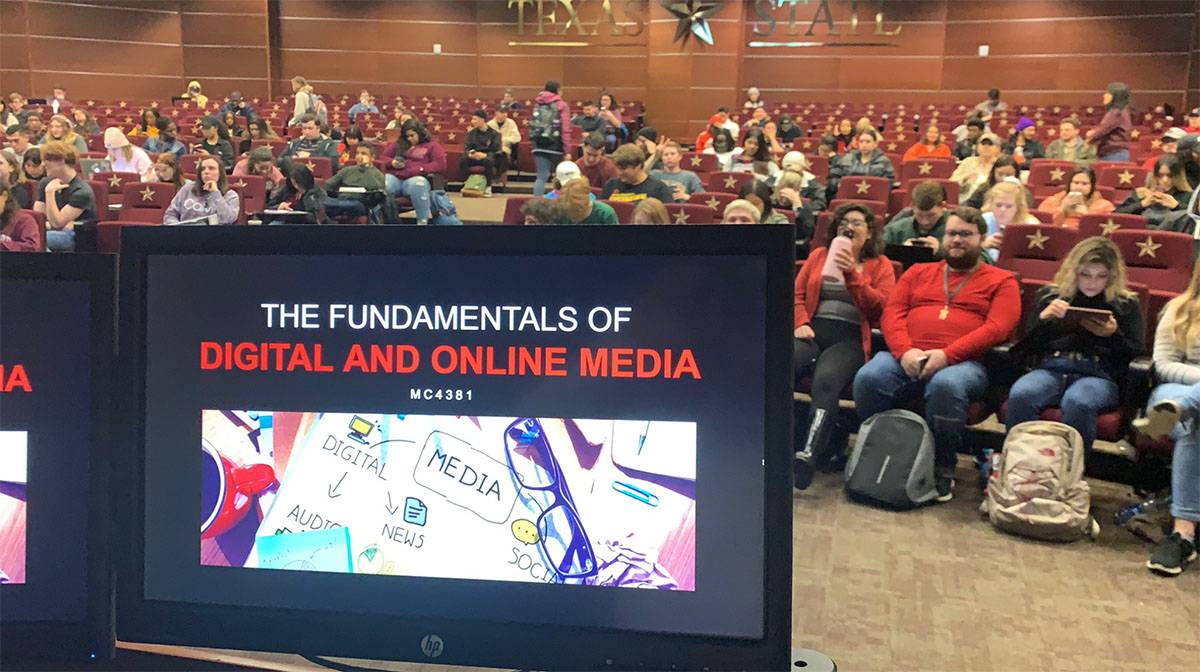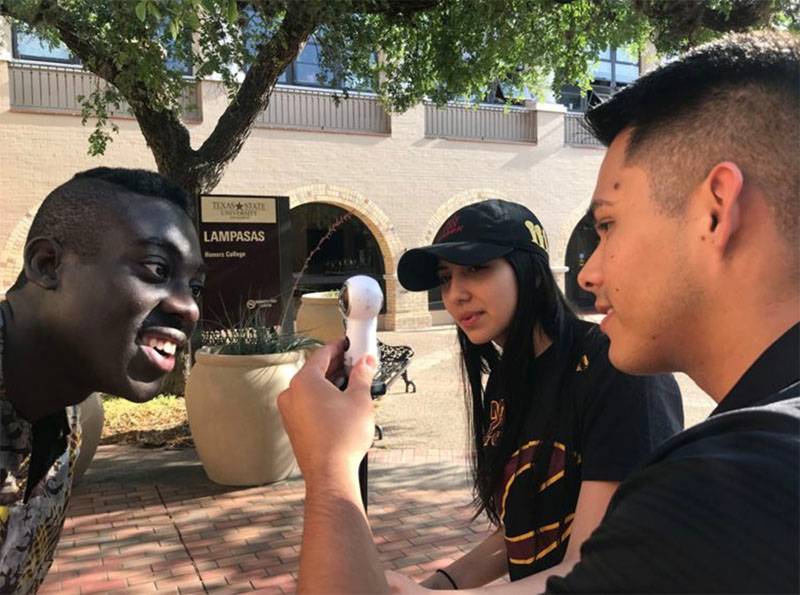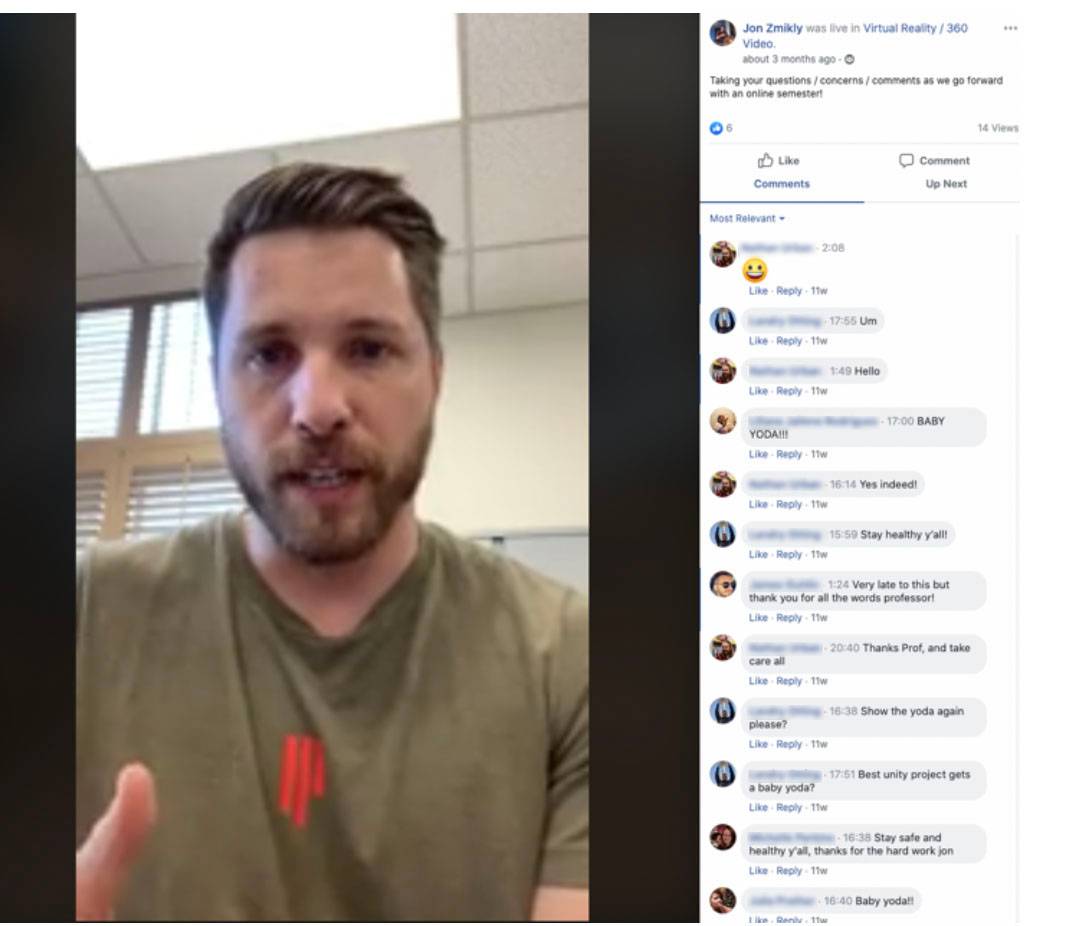
By Jon Zmikly
Senior Lecturer, MILab Assistant Director & Program Coordinator
June 15, 2020
<< Back to Series Intro
As a lecturer with a full load of four courses each semester, planning out a typical school year always requires careful scheduling and organizing. But having taught in higher education for more than 10 years, I have learned firsthand that part of that plan must include a healthy dose of adapting to change. Flexibility goes a long way, especially because no class, no semester and no student is exactly the same.
However, no one could have predicted the complete shift in all of our lives brought on by COVID-19 this past spring semester. The effects of this global and unforeseen pandemic were far-reaching, moving beyond just the classroom and deeply impacting our home lives, communities and our world economy. This brought many new challenges, but it also pushed me to experiment with new tools and teaching formats that I wouldn’t normally have tried.
My Courses
Fundamentals of Digital and Online Media

My largest class, Fundamentals of Digital and Online Media (FDOM), is a required course for all mass communication majors, containing two sections of roughly 200 students each. It provides all of our students with a strong foundation on digital topics and skills from which to build upon during their time in our programs. Since its inception in 2012, this course has moved from being lecture-only to its current state as a hybrid class consisting of lecture, lab and online components. It is a beloved class and is often inspirational for incoming students who are still trying to find their path in the media industry.
With assignments incorporating web writing, coding in HTML and CSS, social media strategy, building an app prototype and digital multimedia, students gain a wide variety of digital skills. In addition, they learn about concepts such as digital media ethics, online business models, as well as emerging trends in media and technology.
Virtual Reality (VR) and 360º Video

Another course I typically teach each semester is called Virtual Reality & 360º Video and focuses on immersive media: virtual, augmented and mixed reality. This is much smaller in size (roughly 18 students per semester) and takes place in a computer lab, meeting twice per week for an hour and twenty minutes each period. This course usually hits the ground running, with students filming their first projects during the second week of classes. During the first half of the semester, students complete two 360º video stories, learning the nuances of recording, editing and publishing virtual reality videos. Then, students build their own immersive environment (and get to experience it in a headset), as well as create augmented reality projects. Not only do students learn how to use the equipment and editing software, but they get a chance to understand what makes immersive media so challenging and exciting though hands-on assignments, class discussion and group work.
Coding and Data Skills for Communicators
I also teach a course called Coding and Data Skills for Communicators. In this course, students learn advanced HTML, CSS and JavaScript skills to develop interactive websites for data storytelling and are introduced to other programming and data concepts relevant to communicators. We work with web frameworks such as Bootstrap, HTML forms and even dabble in Python, web scraping and APIs to gather, interpret and visualize data. This is a very challenging course for students. It is also my most challenging course to teach. Unlike its prerequisite, Web Design and Publishing, students apply programming logic in this course, such as loops, if/else statements and variables to store information. They must wade through many hundreds of lines of HTML, CSS and JavaScript code to get each unique project to function. Though we do not need special software or equipment in this course, we make full use of our time in the computer lab to troubleshoot individual problems and discuss the most effective methods for interactive data, all culminating in a final data storytelling website on a topic of their choice.
The Pandemic
Before spring break, all of my courses had nicely wrapped up the first half of the semester. In FDOM, students had just taken their midterm exams and began getting the hang of the WordPress interface and honing their web writing skills. We had also just slogged through the ever-daunting HTML/CSS project. My other courses had both reached good stopping points as well. Students completed their second 360º videos in my VR class, and my coding students had finished their first project and were just beginning the second.
With stories of the coronavirus circulating in the news, as well as taking an abundance of caution, I spent the week before spring break preparing all of my classes for the possibility of an online-only semester. I remember students appearing visibly shocked that I would even bring up this prospect, but they kept their heads up as I overviewed the rest of the semester and described how future projects might change or adapt in an online environment.
As soon as our university announced an extended spring break, I sent out a Student Learning Insights survey via Google Forms to my FDOM class. This was my biggest concern since it was a required course for all mass communication students, it contained the most students and it had so many different components (lecture, lab and online modules). The survey asked students basic questions regarding their access to technology, as well as open-ended questions about their concerns regarding finishing the semester’s coursework completely online. I was encouraged to see that all students had a smartphone or tablet, 97.8% had a personal computer, and 98.6% had reliable internet. This information greatly informed how I would handle online content and deliver the rest of the semester.

After receiving feedback from all of my students, I used the extra week of spring break to develop a plan of action for each class. I then held live video sessions for students to ask questions and voice their concerns. Since I had already created a Facebook Group for my Virtual Reality and 360º Video course, and we had a class Instagram for FDOM, it was natural to use social media to reach out and video chat in those classes. I also recorded a live Zoom call with my advanced coding class and uploaded it for anyone who was unable to attend. These live sessions were important in getting the word about course changes and updates, and students seemed to appreciate the different forms and platforms for communication.
What Changed?
Labs
Because each of my courses incorporated hands-on learning within a lab setting, this aspect of my courses presented the most dramatic shift to my semester. For FDOM, I worked with my team of nine lab assistants to continue to provide direct digital support, communication and guidance for our students through the rest of the semester. Instead of continuing synchronous lab sessions via video conferencing, we decided to pre-record video tutorials and open up a forum on our learning management system, TRACS, to replace in-class discussion. These forums also acted as lab checkpoints to ensure students were still participating and hitting certain milestones, such as beginning their Build-An-App project, or identiying b-roll footage they planned to use for their video interview assignment.
The transition to online “labs” truly could not have been done without my assistants’ hard work and creative input. They communicated daily with their students and connected with them in ways I simply could not. Because of the prior face-to-face lab sessions, students felt comfortable sharing their struggles and needs with their lab instructor, which was of utmost importance during the pandemic.
One student commented, “You guys made me feel comfortable and personally appreciated and important. You guys worked with us through this pandemic in ways that my other professors didn't. You guys cared about each of us and in turn, I acknowledged that and respected y’all more for that. I failed many times, but y’all heard me out and gave me multiple chances to pick myself up.”
Through the online tutorials and communication, students were able to finish out the semester strong, completing two major assignments and their final website review. I was impressed that many of the projects came out better than a typical semester because, in some cases, students had more time to work and were not limited by 50 minutes in a computer lab. We also modified our grading criteria, offered more credit/no credit options, as well as provided optional written assignments to accommodate students’ technology and time limitations.
Initially, I was also quite worried about transitioning my VR and coding classes for online-only experiences because they require so much in-person communication and side-by-side assistance. Not only do students use high end cameras and computer software in my VR class, they physically need to capture footage and tell stories. And when the world is in lock-down, that becomes increasingly difficult. However, I soon realized the next few projects made use of free software (AR Spark, Unity 3D, Apple’s Reality Composer) that had a plethora of professional and amateur tutorials on the web. After ensuring each student had a computer they could use to download the required software, we continued with course content, and our class calendar was nearly unaffected. Similarly, my coding class simply watched video tutorials each week, and participated in two optional check-ins via Zoom. These offerings allowed them to answer any questions or clarify course content. The only major change was that lab sessions were delivered via our online courses, and they became completely asynchronous.
Lecture
FDOM was my only course with a traditional lecture. In a typical semester, lectures are held in a teaching theater, seating over 400 students. It always feels like an event. Even in such a large room, students can interact with me and each other, participate in discussion and meet with their lab instructors for questions on projects. I often show videos, ask questions and even conduct a trivia game show on Kahoot. There is much energy.
But the transition to an online environment meant all of that would have to change. I knew that most students would have scheduling and technology conflicts. And with so many students, it seemed impossible to continue meeting at our regularly scheduled time. Instead, I pre-recorded all of my lectures and released them on Monday mornings for students to watch at their own pace throughout the week.
Lectures became asynchronous and shorter. Because interaction was not as easy or organic, I shortened my lectures to the bare bones. I broke each topic up into condensed, digestible videos that never exceeded 15 minutes. And thanks to my own video editing skills, I could remove unwanted “um”s and “uh”s, as well as irrelevant information (sometimes lecturers go down rabbit trails). This made each topic succinct and to-the-point, maintaining student attention.
What I Learned
Over-Communication Is Key. When the news of online classes first broke, I recorded a video, sent out an email, and went live on Instagram to answer any questions. I continued to send out a video update each week, along with weekly emails and reminders. I reiterated deadlines as much as possible in the online modules. My lab assistants in FDOM did the same. This over-communication had two effects.
- Students were less likely to miss deadlines. In my initial Student Learning Insights survey, a vast majority of students voiced concerns about potentially missing deadlines and due dates. However, I was thrilled to see more students submitted their assignments online during the quarantine than before it.
- The more we communicated to students, the more comfortable they felt responding back to us. We learned about many personal situations, issues and concerns because of our constant outreach, and could more readily solve both technical and personal problems on a case-by-case basis.
Adapting Is Vital. The Digital Media Innovation (DMI) program is used to change. With new technology and digital issues popping up throughout the media industry, our faculty are constantly learning new skills and integrating them within our curriculum. For us, being flexible is par for the course. And it became an asset during the COVID-19 crisis. I was already immersed in a culture of adapting, so learning new platforms like Zoom were a breeze.
But beyond the technology, deadlines had to move. Expectations changed. It became vital to adapt our requirements and delivery because nothing was normal. Though most students had access to proper technology, many other factors were at play. Most students had to move back to their hometowns. Others lost their jobs. One student emailed me confessing that he was infected with the coronavirus and felt ashamed to tell anyone. Each situation had its own unique problems to overcome, and adaptation was crucial.
In terms of my classes, I canceled a website review altogether in FDOM. I even made the final exam optional (if they were happy with their midterm grade, I would just carry it over for the final). In my VR class, I excused one project for a small number of students because they simply did not have a working computer to install the free software. I video chatted with students at odd hours and helped troubleshoot projects via video chat. The “new normal” was “nothing is normal”, and so we adapted daily. The uncertainty of everything made me appreciate the culture of change and adaptability within our department and faculty, and I will continue to embrace this spirit of agility within my curriculum on a normal basis.
Our Students Are Rock Stars. Above everything, I walked away from this semester with an incredible respect for our students. I was impressed with how each person handled the transition to an online environment, whether they struggled or thrived. The former never hesitated to reach out and get the help they needed; the latter spent extra time perfecting their work and being resourceful. Without skipping a beat, it seemed everyone dug in deeper, locked arms and finished the semester with greater solidarity and strength than they had before.
I also learned how resilient and creative our students can be. One student in the Fundamentals of Digital and Online Media even went so far as to learn a new coding language to begin developing her app prototype into an actual working smartphone application. Another student in my advanced coding class taught herself how to build a searchable database and incorporate it into her final project. I nearly cried at the detailed virtual environments my VR students produced, all on their own.
Despite the fears and anxieties associated with the pandemic, all of my students were communicative and walked out of this semester with highly professional work. Surely, this experience has taught them more than they could ever learn in a typical class in a typical semester, and I am excited to see that agility follow them through each of their digital media futures.
